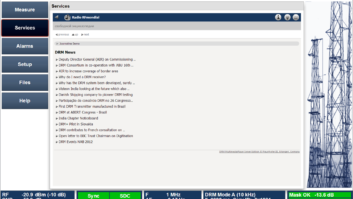NEW DELHI — India will soon welcome another 839 FM radio stations in 227 cities. Added to the private FM stations already running in 86 cities, this means that a grand total of 313 cities will be covered by private FM radio.

AIR transmission tower in Goa for overseas broadcasts. All photos courtesy of Frederick Noronha
The grandness of that number — 313 — may seem to diminish when one considers that India is the second-most populous country in the world; yet it also offers some prospect for radio at time when the medium here has appeared to be stagnating.
With this third stage of radio expansion, new stations will be vying to reach populations of more than 1 million each in many overcrowded cities— a huge potential. The question is whether broadcasters can take advantage of the vast possibilities.
Learned lessons
India began to experiment with the FM band in 1977 in Madras (now Chennai). FM usage then spread to five other cities in the mid-1990s. During that “Phase II” expansion, the country suddenly found itself with several hundred FM channels, which for the most part played the same popular film soundtracks.
Even in cities like New Delhi that have more than 10 stations, there is little variation in format. Stations have tended to favor easy-to-market hits from Indian films, instead of offering specialist music such as classical or jazz or regional-language services, especially after many foreign broadcasters had halted their shortwave Hindi services. With its population of more than 20 million, the city hosts a diverse audience, to say the least. Sending out the same information about traffic, civil services and shopping options to such an assorted range of listeners hardly makes sense.

India learns a ‘new’ medium as private radio gains ground.
Dozens if not hundreds of the FM stations risk going unnoticed in an “unviable market” — exactly what happened in Phase II to many of the FM frequencies available in the Northeast and island territories.
Some private broadcasters, in fact, have voiced their discontent about the addition of stations (and further competition) and have opted out of bidding in Phase III. If however the market could diversify through, for example, a differential licensing policy, then the element of competition would decrease and allow for a greater variety of programming.
The latest Indian Readership Survey (which does not reflect those who tune into radio via mobile phones) suggests that radio listenership has been falling steadily, while television viewership has been rising. And for the most part, short- and medium-wave still dominate the airwaves, since many areas in the country still do not have FM services. Even with this latest phase, many medium-sized town are still being ignored with most stations focusing on the largest centers.

Campus radio station in Maharashtra.
The key to success then may partially reside in the hands of the lawmakers, the Ministry of Information and Broadcasting, a government branch in charge of regulating media in the country. The body has made some strides to — hopefully — facilitate the rollout, and ensure a sustainable landscape. But this may not be enough.
Rules and regulations
Private FM stations, for example, can now rebroadcast news programs from the public broadcaster All India Radio (AIR). The law previously forbade private services to air any news items. Private radio stations however are still not allowed to broadcast original news content, while private television operates freely on the news front. Federal government policy also now allows 26 percent of foreign investment in private radio, vs. the 20 percent previously permitted.
Regarding output power, stations can now transmit an effective radiated power (ERP) of 25 kW to 50 kW in the largest cities, including New Delhi, Mumbai, Kolkata and Chennai, and from 1 kW to 3 kW in cities with a population of 100,000 to 300,000.

Community/campus radio tower set up in New Delhi.
Meanwhile, antenna height or effective height of antenna above average terrain (EHAAT) can range from 20 meters to a maximum of 200 meters.The law also dictates that each station can only use one transmitter with a transmission power of up to 50 kW for A+ cities (New Delhi, Mumbai, Kolkata and Chennai) and up to 30 kW in A cities (with a population of more than 2 million).
While each private FM station is responsible for its own technical resources, the Common Transmission Infrastructure (CTI), a pooled service organized by government-owned bodies, does lease on a cost-sharing basis to private FM broadcasters. Turnkey solutions provider Broadcast Engineering Consultants India Limited (BECIL), a government-run firm, manages CTI. Where possible the new set of lucky radio license winners will also be able to use the transmission towers of AIR and Doordarshan (DD), the public television broadcaster.
Despite some progress in general, the licensing method remains a primary concern. The Ministry of Information and Broadcasting plans to hold an eAuction for the allocation of new frequencies. This could mean that liscenses only go to the highest bidder and may kill any distant dreams of achieving the much needed diversification of format and style — a primary factor for radio to work in this country.
Frederick Noronha, a journalist covering radio issues in India who has campaigned extensively for the legalization of community radio in the country, reports on the industry for Radio World from India.











